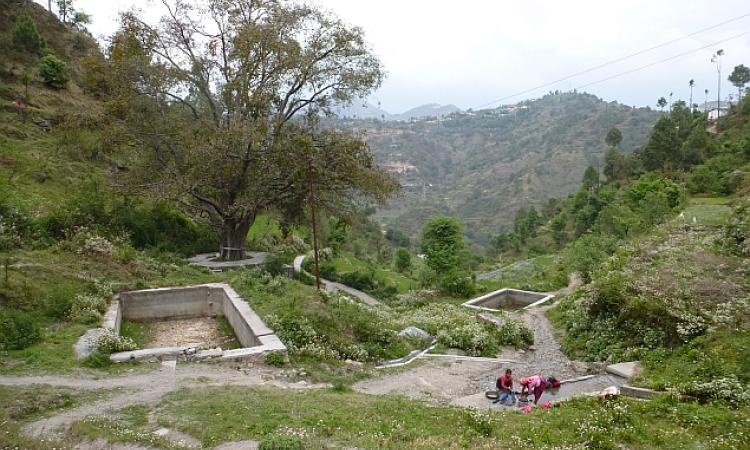
"We did everything ourselves", said the ebuillent Bhuvaneshwari Devi. "We took the cement up, carried the sand, everything! And we even told them where to place the tank"! She went on to narrate how the women's group of which she is a member, taught the men of the village that siting a tank in the stream will place it in danger of being washed away. It is better, they said, to place it beside the stream and further protect it with walls of rock. They had the support of the organisation and the government engineer, so the men complied, and the structure still provides water to the entire village.
Bhuvaneshwari Devi is part of a womens' group – a Mahila Mangal Dal – in the village of Chopriali, Uttarakhand. Earlier, this small village of 63 households was typical of many others in the region. The discharge of the spring they relied on for water supply was becoming erratic, out-migration of youths had led to a decline in agricultural income, and the poor state of sanitation led to health issues.
Matters would have continued in this manner if it were not for a revolution that swept through the village in 2010.
The start of the revolution
It started when HIMCON, an organisation working in the area met with the villagers and chalked out a plan of action to solve their water woes and the all-important issue of livelihood. The first step they took was to establish a Mahila Mangal Dal working on the by now widely understood fact, that trained women's groups make astute managers of public funds.
The organisation sat down with the Mahila Mangal Dal and figured out solutions to their water shortage. A stream, the Channi Gad, was chosen. This was traditionally used by the villagers for water, but a lack of storage meant that the stream could no longer satisfy the needs of the village. The one tank, which had a capacity of 72 cubic metres, lay silted over and defunct.
Getting their hands dirty
The women cleaned out this tank and excavated another one leading to a total storage of 2,00,000 litres. They planned and assisted in the construction of a canal to bring water to a convenient spot. Here another tank, three 'dharas' or water spouts, and space for washing were created. Overflow from the storage tank was directed to another tank used for irrigation. A sand filter was constructed at a spring in Channi Gad and the piped water brought down to the village. The sustainability of this supply was ensured by applying appropriate recharge and soil conservation measures in the recharge area of the spring.
Simultaneously, the villagers were given training in off-season vegetable cultivation, composting, and agricultural techniques. A revolving fund was established solely for the purpose of buying seed. Saplings and seed were distributed among interested farmers.
The villagers now boast of a standpost for every two households. Several families own rainwater harvesting tanks. The village has built up a reputation for itself as a producer of fine vegetables and some farmers have begun supplying the Delhi market.
Today, the Mahila Mangal Dal has taken over the responsibility of managing these diverse systems. They have regular monthly meetings where they plan for maintenance of the sand filter and piped system. They organise regular cleanups of the tanks, and are now planning to build loose boulder structures. The seed fund has increased from Rs. 40,000 to Rs 60,000. Rabi and summer cultivation has increased from a net 5 hectares to a net 17 hectares.
Over and above all the changes in the village is the change in the women. "Bring us any project you have", Bhuvaneshwari Devi commanded me. "We'll implement it".